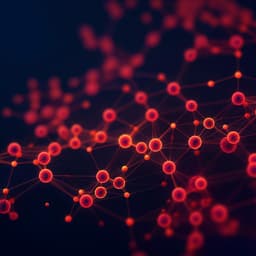
Medicine and Health
A wearable electrostimulation-augmented ionic-gel photothermal patch doped with MXene for skin tumor treatment
X. Ju, J. Kong, et al.
Explore the groundbreaking research by Xingkai Ju, Jiao Kong, Guohua Qi, Shuping Hou, Xingkang Diao, Shaojun Dong, and Yongdong Jin, who developed a skin-mountable eT-patch that combines electrostimulation and photothermal therapy to effectively combat melanoma with minimal side effects.
~3 min • Beginner • English
Introduction
Melanoma is a highly aggressive, easily metastasized skin cancer with low survival rates, motivating the need for simple, feasible, and effective therapies. Wearable biopatches that apply external physical stimuli offer a promising route but existing devices are often complex, costly, and difficult to fabricate. Ionic gels, formed by polymer networks incorporating ionic liquids, present high ionic conductivity, electrochemical and thermal stability, and can be engineered for optical transparency and conductivity, making them attractive for wearable patches. To enhance photoelectric responsiveness for effective therapy, doping with photothermal agents is required. MXenes (e.g., Ti3C2Tx) are two-dimensional materials with excellent electrical conductivity and strong photothermal properties. Combining MXene-doped ionic gels enables simultaneous electrical stimulation (ES) and photothermal therapy (PTT). ES can modulate cellular activity with low damage and has been shown to affect migration, proliferation, differentiation, and induce cell death, partly via mitochondrial dysfunction and ROS overproduction, while PTT provides localized hyperthermia using NIR light. However, traditional photothermal materials (often metallic) lack close skin contact and transparency, preventing real-time monitoring and risking overheating. This work addresses these limitations by developing a transparent, wearable ionic-gel eT-patch doped with MXene for synergistic photothermal and electrical stimulation of melanoma.
Literature Review
Prior approaches include self-powered electrical patches and Joule-heating-based hyperthermia for skin tumors, but many involve complex structures and fabrication, limiting clinical translation. Ionic gels have been reported with high transparency, mechanical strength, and conductivity, and nanocomposite ionogels have been explored for energy devices. MXenes have gained attention for biomedical engineering due to conductivity and photothermal conversion. ES has been used to regulate cellular behaviors and as a cancer therapy modality; mechanisms include mitochondrial dysfunction, ROS generation, and DNA damage. PTT using NIR-absorbing agents is established but traditional agents can hinder skin contact and monitoring. The present study integrates these insights by using MXene-doped ionic gels to achieve co-stimulation (PES), aiming to improve efficacy and safety, while enabling real-time visual monitoring due to patch transparency.
Methodology
Materials and patch fabrication: Ti3C2Tx MXene nanosheets were synthesized by etching Ti3AlC2 (MAX phase) with LiF/HCl, followed by delamination, water dispersion, and freeze-drying. The ionic gel patch used acrylamide (AAM) and acrylic acid (AA) as monomers in the ionic liquid 1-ethyl-3-methylimidazolium (EMIES). MXene powder was dispersed in EMIES and mixed with monomers. Crosslinker N,N'-methylenebis(acrylamide) (MBAA, 0.1 mol%) and photoinitiator Irgacure 2959 (0.1 mol%) were added. The mixture was UV-polymerized (~55 mW/cm²) for 5 min in a mold to form MXene-doped ionogels (eT-patch). Doping concentrations were varied; 0.8 mg/mL MXene was used for most studies. Characterization: MXene structure assessed by SEM, TEM, AFM (~2 nm thickness), XRD (002 peak shift 9.5° to 6.5°), XPS (Ti 2p without oxide at 488.8 eV), and UV-Vis (peak ~768 nm). Photothermal conversion efficiency of MXene nanosheets was calculated (~30%). Patch morphology, element mapping (Ti) confirmed uniform MXene distribution. Mechanical properties (stress–strain, toughness, rheology G' and G''), electrical properties (I–V curves, impedance), optical transparency, and photothermal performance under 808 nm laser (0.5 W/cm²) were measured. Thermal stability was tested over five irradiation cycles. Hydrogel controls (poly(acrylamide-co-acrylic acid) + MXene) were prepared for comparison. In vitro biocompatibility and assays: Cytotoxicity of MXene (MTT) on B16F10 cells; patch extract cytotoxicity on B16F10 at various concentrations and exposure times; tissue compatibility on pork tissue (H&E). In vitro treatment protocols: B16F10 cells on ITO glass were treated under six conditions: control; laser (808 nm, 0.5 W/cm², 10 min); MXene only; PTT (cells incubated with MXene 45 µg/mL, then 808 nm, 0.5 W/cm², 10 min); ES (direct current using three-electrode system with cell-seeded ITO as working electrode, Pt counter, Ag/AgCl reference; various currents 0–10 µA for 10 min, 5 µA selected); PES (ES at 5 µA with concurrent 808 nm laser). Post-treatment, cells were cultured briefly and assessed by MTT and live/dead staining (Calcein-AM/PI). Mechanism studies: RT-PCR for pyroptosis (GSDME, Caspase-3, IL-1β) and apoptosis (Bax, c-Jun, Cyt-c) gene expression; LDH release assay; ATP quantification; mitochondrial morphology by Bio-TEM; ROS detection by DCFH-DA; mitochondrial membrane potential by JC-1; DNA damage by γ-H2AX immunofluorescence. In vivo melanoma model and therapy: C57BL/6J female mice received subcutaneous B16F10 cells (4×10^5). After 7 days (~100 mm³ tumors), mice were randomized to control, laser, PTT, ES, PES groups. Treatments: 808 nm laser 0.5 W/cm² for 15 min on two consecutive days (laser/PTT/PES); PTT and PES used the eT-patch applied over tumor; ES used 100 µA DC through the eT-patch (ES and PES). Tumor thermal imaging monitored temperatures; tumor size measured every 2 days; endpoint at day 15. Current distribution was analyzed by measuring current through free-standing patch vs on-tumor attachment, indicating parallel resistance and current flow through superficial tumor layers. Depth of ablation estimated by H&E and TUNEL (~5 mm). Post-therapy analyses: Tumor volume/weight, body weight, survival (supplementary), tumor histology (H&E), proliferation (Ki-67), apoptosis (TUNEL), GSDME and caspase-3 staining, tumor Bio-TEM, lung metastasis (H&E), major organ histology (H&E), hematology panels. Statistical analyses used two-tailed t-tests; data reported as mean ± SD with replicates as specified in figure legends.
Key Findings
- MXene nanosheets (Ti3C2Tx) were successfully synthesized (2D ultrathin ~2 nm; XRD peak shift; XPS confirmed surface terminations without oxidation) and showed strong NIR absorption (~768 nm) with high photothermal conversion efficiency (~30%), exceeding Au nanorods (21%) and Cu9S5 (25.7%).
- MXene-doped ionic gel patches (eT-patch) exhibited uniform MXene distribution, improved ductility and toughness; elongation at break reached ~745% (at ~5.75 MPa) at 0.8 mg/mL MXene.
- Photothermal performance: Under 808 nm, 0.5 W/cm² for 10 min, the 0.8 mg/mL MXene eT-patch reached ~62.4 °C and maintained thermal stability over five on/off cycles. Temperature increased with MXene concentration, laser power, and patch thickness; temperature uniformity across the patch was observed.
- Electrical performance: MXene doping increased conductivity; current at 5 V rose with MXene concentration; impedance decreased from ~1539 Ω (pure gel) to ~1139 Ω (MXene-doped). Laser-induced heating further increased current (photothermal-enhanced conductivity).
- Compared to MXene-doped hydrogels, the eT-patch showed superior cycling thermal stability, electrical conductivity, and mechanical strength/strain.
- Biocompatibility: MXene (≤45 µg/mL) and patch extracts showed high B16F10 cell viability (>80% after brief exposure); ex vivo tissue (pork) showed no structural damage from patch contact; patches retained optical transparency at 0.8 mg/mL MXene, enabling visual monitoring.
- In vitro therapy: PES (ES + 808 nm PTT) produced the strongest cancer cell killing versus control, laser, MXene alone, PTT, or ES. Normal L929 fibroblasts were less affected than B16F10 cells. Morphology suggested ES induced pyroptosis (cell swelling) and PTT induced apoptosis (cell shrinkage).
- Mechanisms: PES significantly upregulated pyroptosis markers (GSDME, Caspase-3, IL-1β) and apoptosis markers (Bax, c-Jun, Cyt-c). LDH release increased in ES and PES; cellular ATP decreased most in PES. Bio-TEM revealed mitochondrial cavitation/swelling after PES. ROS increased (DCF fluorescence), mitochondrial membrane potential decreased (JC-1 shift), and γ-H2AX staining indicated highest DNA double-strand breaks in PES.
- In vivo therapy: PES achieved the most pronounced tumor suppression among groups, with surface temperatures rapidly increasing during treatment; surrounding tissue temperatures ~40 °C suggested limited collateral damage. Effective ablation depth reached ~5 mm. Tumor weights and relative volumes were lowest in PES; body weights remained stable, and survival improved (supplementary). Histology showed maximal tumor damage and proliferation inhibition (H&E, Ki-67), high apoptosis (TUNEL), GSDME decrease consistent with caspase-3-mediated cleavage, and severe mitochondrial damage by TEM. No lung metastasis was observed; major organ histology and hematology showed no significant toxicity.
Discussion
The study addresses the need for a simple, effective, and safe wearable therapy for melanoma by integrating MXene-based photothermal conversion with ionic-gel-enabled electrical stimulation in a transparent eT-patch. MXene doping simultaneously enhances photothermal efficiency and electrical conductivity while preserving transparency for real-time monitoring. The co-therapy (PES) outperforms single-modality treatments due to synergistic mechanisms: ES perturbs mitochondrial function, elevates ROS, and disrupts redox homeostasis, while PTT provides localized hyperthermia; together they intensify ROS accumulation, reduce mitochondrial membrane potential, and cause extensive DNA damage. This dual action triggers both apoptosis and pyroptosis, leading to robust tumor cell death. In vivo, PES achieves significant tumor suppression with limited off-target heating, minimal systemic toxicity, and no observed promotion of metastasis, supporting its relevance for superficial skin tumors. The results demonstrate that a mechanically robust, thermally stable, and conductive ionogel platform can deliver controlled photoelectric stimulation, offering a clinically translatable strategy for skin cancer management.
Conclusion
A transparent, wearable MXene-doped ionic-gel eT-patch was developed to deliver combined photothermal and electrical stimulation for melanoma therapy. The patch exhibits high photothermal conversion, enhanced conductivity, strong mechanical properties, and stable cycling performance. PES induces synergistic apoptosis and pyroptosis via ROS-mediated mitochondrial dysfunction and DNA damage, yielding superior tumor ablation in vitro and in vivo with favorable biosafety. This easily fabricated platform enables real-time visual monitoring and may reduce the need for invasive surgery in superficial tumors. Future work should optimize dosing parameters (current, duration, laser power), assess long-term outcomes and recurrence, expand to other skin and subcutaneous tumors, evaluate human-relevant models, and integrate closed-loop temperature/current control to further enhance safety and efficacy.
Limitations
- The in vivo studies were conducted in a murine B16F10 melanoma model with relatively small group sizes and short follow-up (15 days), limiting assessment of long-term efficacy, recurrence, and immune responses.
- Effective ablation depth was approximately 5 mm, suggesting applicability may be limited to superficial tumors or require multiple sessions for thicker lesions.
- Transparency decreases with higher MXene loading, indicating a trade-off between optical monitoring and photothermal/electrical performance.
- Only specific stimulation conditions were tested (808 nm, 0.5 W/cm²; ES 5 µA in vitro and 100 µA in vivo); broader parameter optimization and dose–response relationships remain to be systematically explored.
- Comparisons to standard-of-care therapies and combination with systemic treatments were not evaluated.
- Long-term biocompatibility and stability under repeated clinical-like use were not fully assessed.
Related Publications
Explore these studies to deepen your understanding of the subject.







